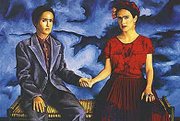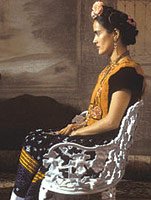Painterly Fashions Distinguish 'Frida'
The movie: “Frida”
The costume designer: Julie Weiss, who has worked extensively in television and theater and whose film credits include “Searching for Bobby Fischer,” “Steel Magnolias,” “Fear and Loathing in Las Vegas,” “Honeymoon in Vegas,” “Twelve Monkeys” and “Auto Focus”
FYI: Mexican painter Frida Kahlo (Salma Hayek) left behind a treasure trove of information for anyone interested in duplicating her remarkable personal style since she herself was the subject of many of her paintings. During certain periods, she would dress in men’s suits (Weiss also saw a photo of her in jeans), but she was at her most captivating in the fantastic, colorful, embroidered Tehuana Indian costumes for which she is most identified. Either way, once Frida married painter Diego Rivera in 1929, she eschewed the Western-style fashions worn by most other contemporary women in Mexico City. Even on trips to Paris, New York and Chicago, when Rivera was at the height of his fame, Frida, a fashion independent, went Mexico style. “She was a non-traditionalist in traditional dress,” explains Weiss.
Individualist: It’s no wonder that today’s fashionistas see something in Frida Style they can relate to. In one scene, on her wedding day, Frida, at the last minute, ditches the frou-frou, white lace gown she was intended to wear and slips into the common peasant clothes of her maid—a plain, long green cotton dress, red shawl and chunky beads, her hair twisted up on her head—immortalized in the painting “Frida and Diego Rivera (The Wedding Portrait).”
Details: Frida mainly wore embroidered tops, both simple and elaborate; ankle-length, layered and flounced skirts, many in what Weiss calls “daily” floral cotton prints; a reboso (shawl); and a mad mix of wonderfully eclectic jewelry that included thick silver drop earrings or a delicate gold filigree necklace, chunky amber beads and multiple rings including cheap trinkets that merely amused her. “Her combinations were so glorious.”
Searching for Frida:Weiss found many of the blouses, printed fabrics for skirts, and jewelry in the marketplaces in Mexico City where Oaxacan merchants sell the very same styles worn by Frida. “The past is available in Mexico,” Weiss says happily. The racks at Palace Costume and Western Costume in Los Angeles, with their period garments, were also important sources, but so were chance finds. Hayek brought in a reboso that was her grandmother’s; a woman in Mexico who heard about the filming offered an outfit. One of Frida’s biographers showed Weiss a blouse with rickrack that belonged to the artist and Weiss created her own version of it. Even the owner of Palace Costume contributed some of her own jewelry that she purchased when she visited Mexico as a child. A workshop was also set up near the Mexico City set where Weiss kept an embroiderer busy.
Trend watch: Asked whether “Frida” fever will grip trend-conscious women, Weiss replies, “I think it’s here already. You don’t have to go to Olvera Street. If you walk down any street, the Promenade or Melrose Avenue, it is here. You’ll see the filigree jewelry, the large stones, the pattern on pattern, the beautiful tops, a reboso, floral cotton. But it has to be worn by a person who can celebrate when they get dressed. We’re all too often a beige society.” —Betty Goodwin























